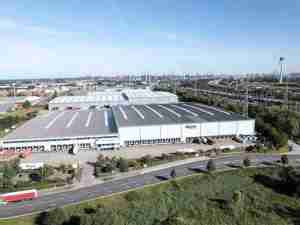The Maryland Port Administration (MPA) recently was recognized twice for its environmental initiatives, receiving a successful recertification audit of its Environmental Management System (EMS) from the International Organization for Standardization (ISO) 14001 and taking first place for its Algal Turf Scrubber ® (ATS™) in the Innovative Best Management Practice (IBMP) Award by the Chesapeake Stormwater Network. The network consists of nearly 5,000 stormwater professionals, primarily comprised of members within the Chesapeake Bay Watershed, but also has members from around the world.
“With their strong connection to the Chesapeake Bay and other vital Maryland waterways, the Port of Baltimore plays a key role in our commitment to create a healthier, more sustainable Maryland,” said Governor Martin O’Malley. “I congratulate the hard working men and women at the Port Administration for receiving this recognition and thank them for their ongoing efforts to protect and preserve the environment.”
The ISO 14001 certification standards are among the most challenging in the environmental industry. Out of 360 U.S. seaports, less than ten are ISO 14001 certified. Through these standards, the MPA has successfully identified and controlled the environmental impacts of activities, products and services; improved environmental performance; and implemented a systematic approach to setting and meeting environmental goals and objectives.
In the last few years, the MPA has implemented the following environmental initiatives:
The ISO certification is beneficial to an organization as it increases efficiencies in the usage of raw materials and energy, reduces waste and cost, and complies with environmental regulations. The certification status is good for three years.
- Installed renewable energy solar panels on the roof of the Port of Baltimore’s cruise terminal and a cargo storage warehouse. The solar panels have reduced the reliance on the electrical grid and have produced more than 910,398 kilowatt-hours of electricity.
- Replaced more than 80 dray trucks with cleaner models resulting in a reduction of greenhouse gas emissions.
- The MPA will reduce its electricity and water consumption at the World Trade Center Baltimore though a geothermal heat sink, which uses water from the Inner Harbor to cool the building.
Another environmental achievement for the Port was recently winning first place in Innovative Best Management Practice Award for the Port’s Algal Turf Scrubber. The 300 foot-long turf scrubber works by pumping water from Baltimore’s Patapsco River into a shallow screened trough at the Port of Baltimore’s Dundalk Marine Terminal. The water flows through the trough where the growth of natural algae occurs through nutrient uptake and releases dissolved oxygen, providing an improved water quality to the river. The ATS project was a partnership with the University of Maryland, Biohabitats, Inc., Living Ecosystems and Maryland Environmental Services.
The ATS is part of the MPA’s Water Quality Management Plan, which is a guide to reducing the impact of stormwater runoff from the Port of Baltimore’s public marine terminals. It includes assessing existing conditions and structures at the Port, examining nutrient and sediment loads leading from the Port into the Patapsco River and an analysis of stormwater treatment best management practices.
“The nutrients and carbon biomass removed from the system through the algae harvest have been used to develop alternative carbon neutral energy sources, create manufactured soils, or have Omega 3 dietary supplements extracted,” said Dr. Peter May of Biohabitats, Inc. “As the sun's natural energies help the algae rapidly grow, the algae is doing the work for us in effectively removing nutrients from impaired waters so we can use this ecologically engineered system as one tool to help solve a part of the pollution problem within the Chesapeake Bay.”
Working with its state and local partners, the Port is working to meet federal mandated goals for water quality, known as Total Maximum Daily Loads (TMDL) for nitrogen, phosphorus and total suspended sediments that were established in a 2009 Executive Order signed by President Barack Obama to protect and restore the health of the Chesapeake Bay. The Algal Turf Scrubber is an essential tool in meeting these federal goals as it pumps polluted water through a scrubber, where the algae removes excess nitrogen and phosphorous.









